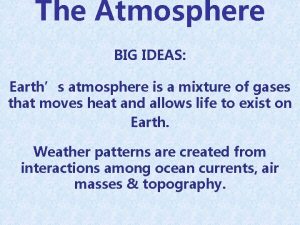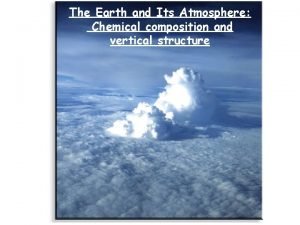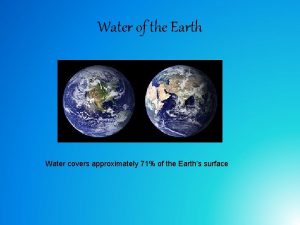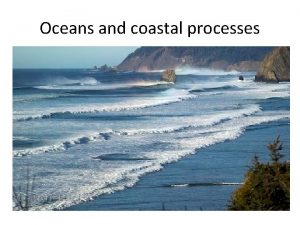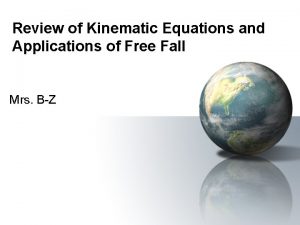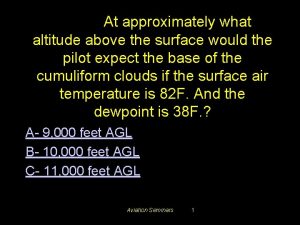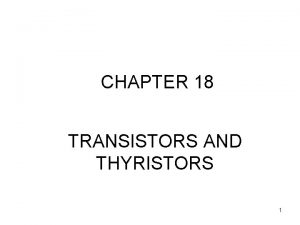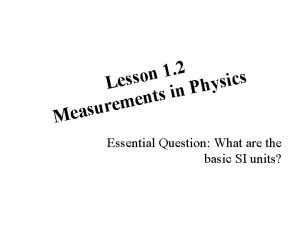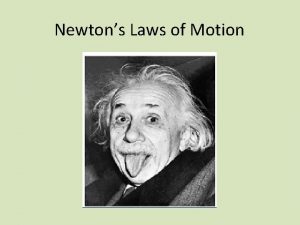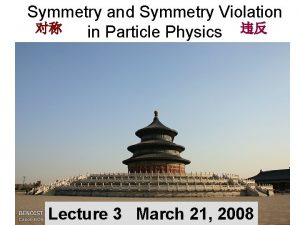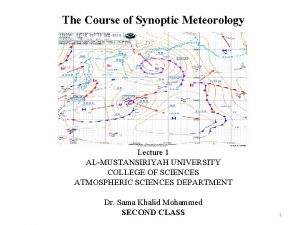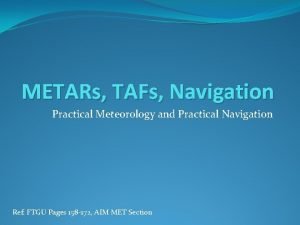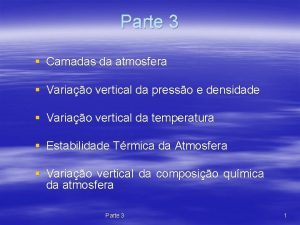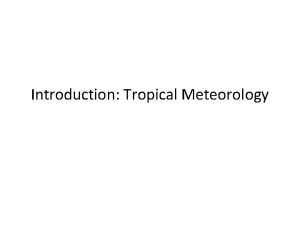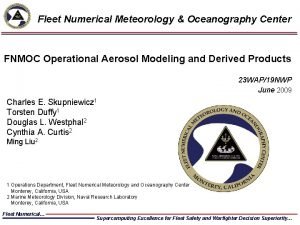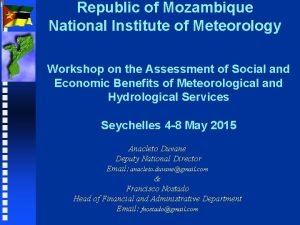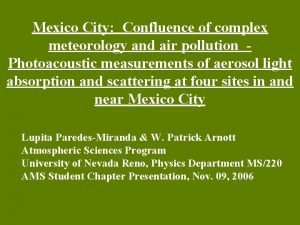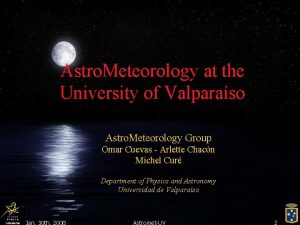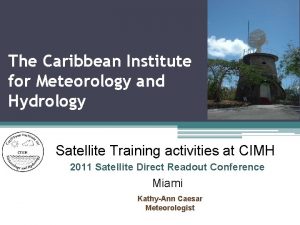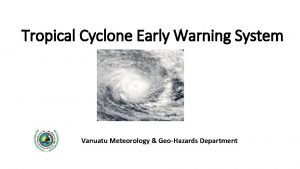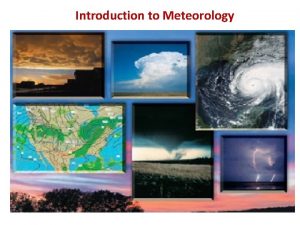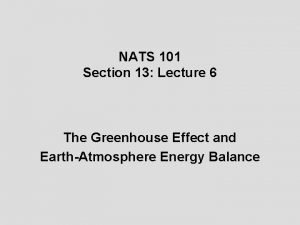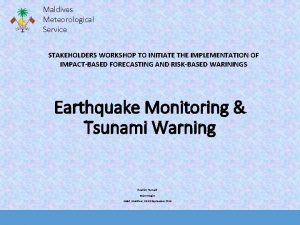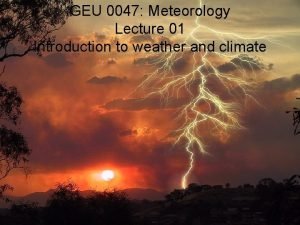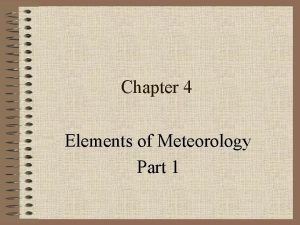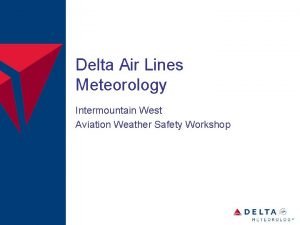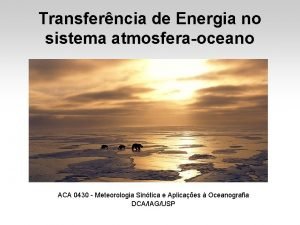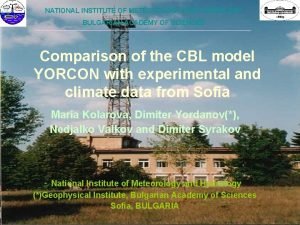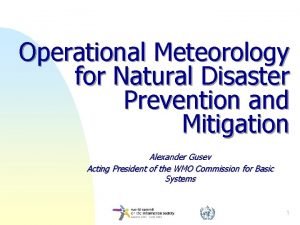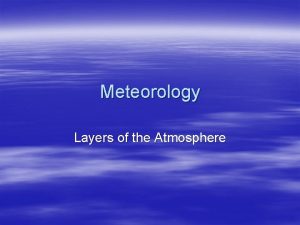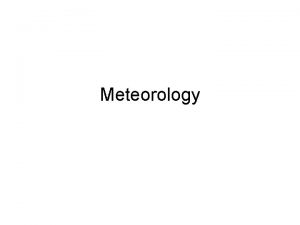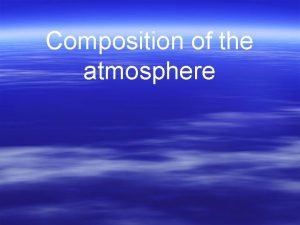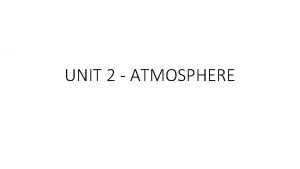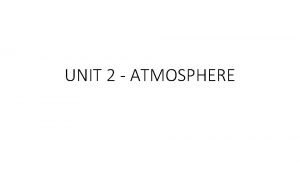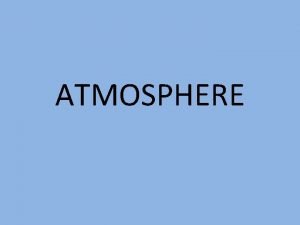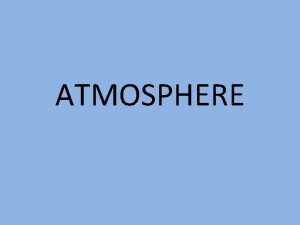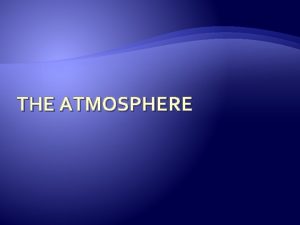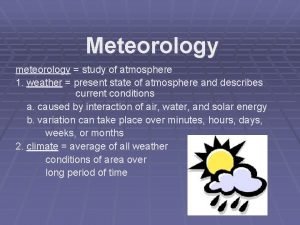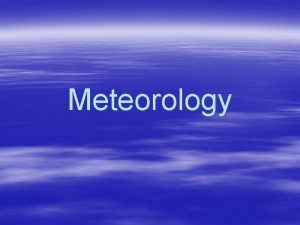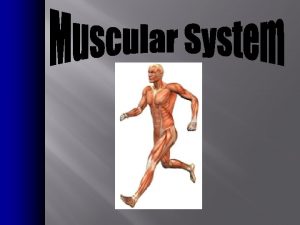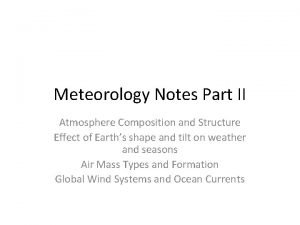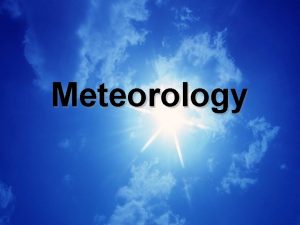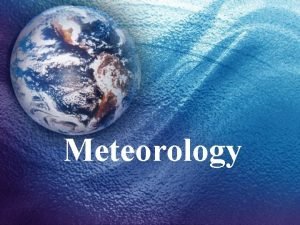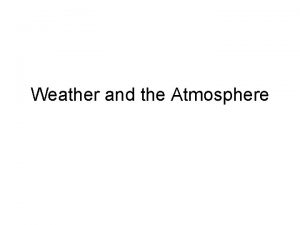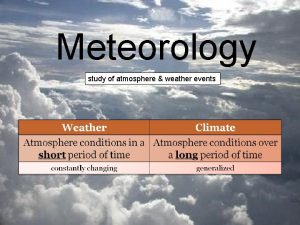Meteorology The Atmosphere Composition of the Atmosphere Approximately









































- Slides: 41

Meteorology The Atmosphere

Composition of the Atmosphere � Approximately 99% of the atmosphere is made up of Nitrogen and Oxygen. Nitrogen(N 2) and Oxygen(O 2) have very little impact on the weather. � Water vapor(H 2 O) is a VARIABLE component that has a large impact on weather and climate. Water vapor can make up from 0% to 4% of the atmosphere. � Ozone (O 3) is a form of oxygen that helps to filter most UV radiation protecting living organisms from the harmful effects of the sun. � Pollutants vary from place to place. • Transportation (cars, trucks, trains, etc. ) accounts for almost HALF of all the pollutants in the atmosphere.

Volume of Clean, Dry Air

Structure of the Atmosphere �The atmosphere changes rapidly as you move up in altitude. �The atmospheric pressure (weight of the air) drops drastically as you increase altitude. • In other words, the air gets thinner as you go up. �The temperature also changes as you increase your altitude. However, it is not a steady decrease like air pressure.

Atmospheric Pressure vs. Altitude

Structure of the Atmosphere �There are FOUR divisions or layers of the atmosphere based on temperature

Troposphere – the bottom layer of the atmosphere � It begins at the Earth’s surface and extends up to 4 -12 miles high. � We live in the Troposphere. � The temperature DECREASES as you go up in the troposphere. ( 62 o. F to -60 o. F) � Almost all weather occurs in this layer. � The boundary between the troposphere and the layer above is called the Tropopause.

Stratosphere – the 2 nd layer of the atmosphere – Middle layer �It begins at the tropopause and extends up to 31 miles above the Earth’s surface. �The temperature increases with height (76 o. F to 5 o. F) due to the absorption of radiation. �The boundary between the stratosphere and the layer above is called the Stratopause.

Mesosphere – the 3 rd layer of the atmosphere – Middle layer � It begins at the Stratopause and extends up to 53 miles above the Earth’s surface. � The gases get increasingly thinner as you move up in height. � As a result, radiation warms the atmosphere less so the temperature drops (5 o. F to -184 o. F) � This layer protects us from meteors, as they often burn up in the mesosphere so they never reach Earth. � The boundary between the mesosphere and the layer above is called the Mesopause.

Thermosphere – the 4 th layer of the atmosphere – Upper layer � It begins at the Mesopause and extends up to 430 miles above the Earth. � Gases are even thinner here. � Temperatures increase as this layer is not protected from the sun’s radiation. (up to 3, 600 o. F) � Contains the ionosphere which is made up of electrically charged gas particles. � The boundary between the Thermosphere and the layer above is called the Thermopause.

Exosphere - the outermost layer �It extends from thermopause to 6, 200 miles above the earth. �Satellites are found in this layer

Thermal Structure of the Atmosphere

Heat and Temperature

Heat Transfer Methods �Conduction �Convection �Radiation

Radiation �All objects, at any temperature, emit radiant energy. �Hotter objects radiate more total energy per unit area than colder objects do. �The hottest radiating bodies produce the shortest wavelengths of maximum radiation. �Objects that are good absorbers of radiation are good emitters as well.

Since, all objects give off energy, what happens when that energy from radiation hits an object? 1. 2. 3. Some energy is absorbed by the object. Some energy goes straight through air and water. Some energy may bounce off the object. This is called reflection. • Scattering can also occur. This is when light is split into more rays that are weaker (not as bright). �Scattering is how light brightens a room even when you can’t see the source. �Scattering is also why the sky is blue.

Greenhouse effect �The process by which gases (carbon dioxide and water) absorb energy radiated by Earth and use it to heat the atmosphere. �Is the Greenhouse effect and Global Warming the same thing?

Factors that affect Temperature �Location, Location • Latitude – the further from the equator the lower the average temperature • Geographic position – direction of wind, presence of mountains, etc. can affect temperature

Factors that affect Temperature � Water – locations close to bodies of water (lakes, seas, oceans) have temperatures that stay more constant. • Land heats more rapidly and to higher temperatures than water. • Land cools more rapidly and to lower temperatures than water. � Altitude – the higher up you go, the lower the temperature � Clouds – the presence of clouds lowers the temperature

Temperature graphs pgs 489 -491 �Compare and contrast the temperature value for the blue and red lines on each graph. • Compare – What is the same? • Contrast – What is different? �Figures 15, 16, 17, and 18

Water in the Atmosphere

Water’s Changes of State � Solid to Liquid • The process of changing state, such as melting ice, requires that energy be transferred in the form of heat � Liquid to Gas • Evaporation is the process of changing a liquid to a gas. • Condensation is the process where a gas, like water vapor, changes to a liquid, like water �Solid to Gas • Sublimation is the conversion of a solid directly to a gas without passing through the liquid state. • Deposition is the conversion of a vapor directly to a solid.

Changes of State

Lab: Humidity and Dew Point �You will need: textbook – page 524 -525 blank sheet of paper pen or pencil

Water in the Atmosphere �Humidity • a general term for the amount of water vapor in air �Precipitation • any form of water that falls from a cloud. • Types of Precipitaion �Rain, Sleet, Snow, Hail

Largest Recorded Hailstone

Cloud Types and Precipitation Types of Clouds �Clouds are classified on the basis of their form and height. • Cirrus (cirrus = curl of hair) are clouds that are high, white, and thin. • Cumulus (cumulus = a pile) are clouds that consist of rounded individual cloud masses • Stratus (stratus = a layer) are clouds best described as sheets or layers that cover much or all of the sky.

Cloud Classification

Air Pressure and Wind

Air Pressure �Air pressure is the pressure exerted by the weight of air. • Air pressure is exerted in all directions— down, up, and sideways. • The air pressure pushing down on an object exactly balances the air pressure pushing up on the object. • A barometer is a device used for measuring air pressure.

Wind � Wind is the result of horizontal differences in air pressure. Air flows from areas of higher pressure to areas of lower pressure. �Three factors combine to control wind: pressure differences, the Coriolis effect, and friction.

Factors affecting Wind Pressure Differences �A pressure gradient is the amount of pressure change occurring over a given distance. � Closely spaced isobars—lines on a map that connect places of equal air pressure— indicate a steep pressure gradient and high winds. � Widely spaced isobars indicate a weak pressure gradient and light winds.

Isobars

Factors affecting Wind Coriolis Effect �The Coriolis effect describes how Earth’s rotation affects moving objects. • In the Northern Hemisphere, all free-moving objects or fluids, including the wind, are deflected to the right of their path of motion. • In the Southern Hemisphere, they are deflected to the left.

The Coriolis Effect

Factors affecting Wind Friction �Friction acts to slow air movement, which changes wind direction.

Wind and Air Pressure Highs and Lows �Cyclones are centers of low pressure • In cyclones, the pressure decreases from the outer isobars toward the center. �Anticyclones are centers of high pressure • In anticyclones, just the opposite is the case—the values of the isobars increase from the outside toward the center.

Cyclonic and Anticyclonic Winds

Airflow Patterns, Surface and Aloft

Local Winds � The local winds are caused either by topographic effects or by variations in surface composition—land water—in the immediate area. � Land Sea Breezes • During the day in summer, the land heats more quickly than the water. • As a result, the air above the land surface heats, expands, and rises. • This creates an area of lower pressure. • At night the reverse takes place.

Sea and Land Breezes
 Hsocl
Hsocl Explain composition and structure of atmosphere
Explain composition and structure of atmosphere Earth atmosphere composition
Earth atmosphere composition Water covers approximately
Water covers approximately Which is approximately equal to sin a
Which is approximately equal to sin a The constant-current area of a fet lies between
The constant-current area of a fet lies between Jetties
Jetties Luke autbeloe drops an approximately
Luke autbeloe drops an approximately Steady precipitation preceding a front is an indication of
Steady precipitation preceding a front is an indication of Q point
Q point Classical period 1750 to 1820 romantic period
Classical period 1750 to 1820 romantic period A hydrogen atom has a diameter of about 10 nm
A hydrogen atom has a diameter of about 10 nm Luke autbeloe drops an approximately
Luke autbeloe drops an approximately A charm quark has a charge of approximately
A charm quark has a charge of approximately The earth formed approximately
The earth formed approximately Synoptic meteorology definition
Synoptic meteorology definition Cin meteorology
Cin meteorology Introduction to tropical meteorology
Introduction to tropical meteorology Metar codes
Metar codes Anders persson meteorology
Anders persson meteorology Meteorology today
Meteorology today Math in meteorology
Math in meteorology Introduction to tropical meteorology
Introduction to tropical meteorology Fnmoc
Fnmoc National institute of meteorology
National institute of meteorology Confluence meteorology
Confluence meteorology Astro meteorology
Astro meteorology Caribbean weather satellite
Caribbean weather satellite Meteorology jeopardy
Meteorology jeopardy Weather station model
Weather station model Vanuatu meteo cyclone warning
Vanuatu meteo cyclone warning Mesopause definition
Mesopause definition Meteorology today
Meteorology today Department of meteorology maldives
Department of meteorology maldives Meteorology lecture
Meteorology lecture Elements of meteorology
Elements of meteorology Delta meteorology
Delta meteorology Penn state meteorology jobs
Penn state meteorology jobs Meteorology
Meteorology Meteorology today
Meteorology today Yorcon
Yorcon Operational meteorology
Operational meteorology

